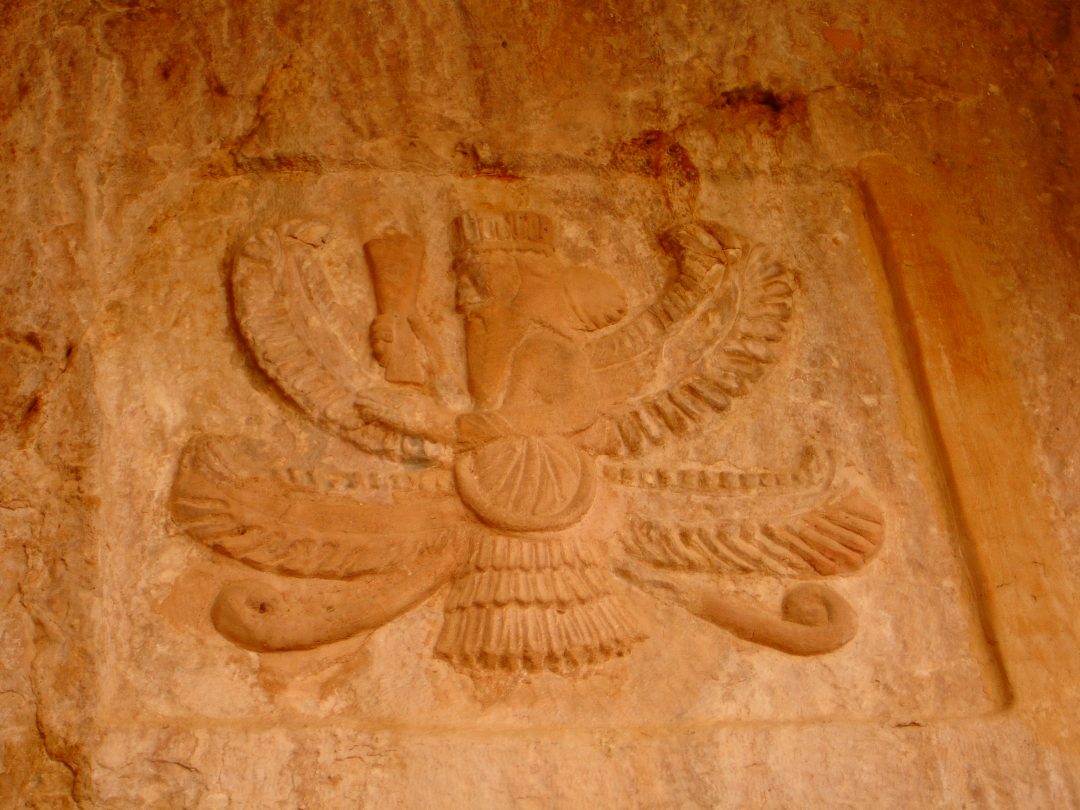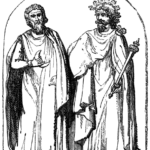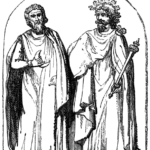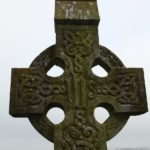Near Eastern religion encompasses a number of religions and a large era of time.
Almost 4000 years separate the Sumerians and pre-dynastic Egyptians from Zoroastrianism, the last widespread religion before the rise of Christianity.
The principal common denominators between the faiths that guided the people of Mesopotamia – Ur, Sumer Babylon (Iraq and Syria), Assyria, Egypt, Anatolia (Turkey), and Persia (Iran) are:
Some common characteristics that those faiths shared are:
– These faiths were polytheistic the people of the near east believe in many gods, as opposed to a monotheistic religion where only one god prevails (except for Zoroastrianism);
– They were believed in supernatural powers, both benevolent and malevolent, such as demons, angels, and another kind of spirits;
– Ritual was an important part of the religion: Sacrifices to the gods, like animal, crops, and produce like wine) were common to the region;
– They believed in divination and magic and made profuse use of omens, amulets, incantations, and spells;
– They believed in purification and used it in many circumstances.
– The leader of the civilization (king, pharaoh) was closely connected to the Gods and head of the religion (except for Zoroastrianism).
SUMER
Sumer is the oldest civilization recorded in Mesopotamia. Excavations have dated the earliest remnants of this civilization to as far as the 4rth millennium BC. Along with the civilization of the Valley of Indus and pre-dynastic Egypt, they were the first sign of a sedentary way of life and development of civilization: they farmed land, hunted, possessed domestic animals and developed religion and culture, nominally in the arts (ceramics, painting, dance, music). Their religion was oriented on fertility rites, superstition, and the cult of the bull, a male figure. The Gilgamesh Epic is one of the legends that originate from Sumer. An important God was Enlil, ruler of the land, who gave human spells and incantations to force the spirits of the land to obey their command. Enki is another God, the god of fertility, abundance, lord of the water. He presided over healing sciences and arts and is believed to have created the earth.
EGYPT
From the 3rd millennium BC, Egypt’s civilization reached the Kingdom state, ruled by the pharaohs. The Capital of the Kingdom was Memphis, and this period is best known for the construction of the pyramids.
The Pharaoh was believed to be the incarnation of a God, responsible for the continuing cycle of the seasons, and deserved worshipping as such. Proper revering of the Pharaoh would bring the annual flooding of the Nile, necessary to ensure irrigation of the crops and a good harvest. Beside the pharaoh, Egyptians have numerous Gods who shared powers and roles in human affairs:
– Amen (god of the creation)
– Shu (god of the air),
– Nut (god of the sky and heavenly bodies)
– Geb (god of the earth),
– Osiris (God of the dead and the underworld),
– Isis (Mother goddess)
– Set (God of the Storms, Chaos, and Evil)
– Nephthys, (Goddess of the dead)
– Horus (Father of the Pharaohs),
– Anubis (god of mummification),
– Amon (God of the wind)
– Ra (God of the Sun) (Amon-Re later became Kings of Gods)
– Thoth (God of the Moon and sacred writing)
– Ka (God of the souls)
– Ma’at (Goddess of Justice and truth)
– Bast (goddess of the cats)
– Hathor (Goddess of the cows, love, dance)
– Min (God of fertility)
Egyptians are renowned for their elaborate ritualization of death (mummification). Priests were the most powerful people after the pharaohs because they were able to speak about the will of the gods.
BABYLON
Situated near the ancient site of Sumer, Babylon reached its peak around 1800 BC. The city is nest known for one of the wonder of the world was built there, the Hanging Garden. Babylon is also known for having written the oldest code of law, the Hammurabi code. Babylon may have been the first civilization to link the movements of the stars with the will of deities, even identifying heavenly bodies (stars, planets, sun, and moon) with deities, which eventually gave birth to astrology. Popular gods were:
– Anu (ruler of the heavens, the constellations, spirits and demons, King of Gods)
– Enlil (ruler of the earth, air, wind)
– Ea (or Enki) (ruler of the crafts, intelligence, wisdom and waters- it is believed that Enki created the multitude of language, a legend that is reported in Bible with the Babel tower myth),
– Ki (or Nin) (mother earth, originated from Sumer and was kept by the Babylonians as an important deity)
– Ishtar (or Astarte) (mother goddess, goddess of the earth, fertility, of war, of love, marriage and fate)
– Sin (In Sumer Sama) (God of the moon, of astrology)
– Shamash (In Sumer Utu) (God of Justice, the Sun, and agriculture)
Babylon is often referred to in the Bible as a place of confusion, a place of sins because of the worship of several gods and a concurrent to the realm of Israel and Juda. Israel has never forgotten that Nebuchadnezzar was the first king to conquer Israel, raze the temple and send the people of Israel to exile in Babylon. It was the Persian king Cyrus (a Zoroastrian) who freed the people of Israel (see Zoroastrianism below)
HITTITES
Established in Anatolia (Turkey) around 1800 BC, the Hittites build a large empire that lasted for about 600 years. They are believed to be the link between the Egyptian culture, and the Greek and Roman culture. They developed great skill in iron crafting and transportation in pioneering the chariot. Their religion resembles that of other Mesopotamian spiritualities. They were conquerors: they carried their religion to many places with them. But they were fair, they didn’t impose their religions, instead, when they conquered a place, they integrated the foreign gods into their pantheon. They ended up having hundreds of Gods. Some innovations tend to indicate they were influenced by the passage of Indo-European tribes: Fertility gods like the serpent Illuyanka shares the pantheon with a God of thunder (Tarhunt). The Hittites believed in Magic and witchcraft; they used divination and sacrifices profusely. Their Empire lasted until the middle of the 12th century BC.
MINOAN
The Minoan civilization was situated on the island of Crete, and was very active during the Bronze Age, from the 27th century BC to the 14th century BC. Only ruins and classical texts from the Greeks are left from this civilization, so archaeologists can only deduce what their religion was. The Minoan civilization differs radically from other Near Eastern religions in that it would seem to have been matriarchal, instead of patriarchal like all the other Mesopotamian religions.
The Minoans rendered a cult to many goddesses:
– The snake goddess (a household deity)
– The goddess of animals (represented with lions flanking her side)
– The goddess of vegetation
– Male divinities are often represented smaller in size than the female divinities and only come toward the end of the civilization.
Some of the best-known symbols of the Minoan religion were the tree, which was very important to the Minoans, the pillars (another form of tree), the horns, the double-headed axe, and the serpent. They engaged in sacrifices, animal, vegetal and human; they believed in spirits, genies, and demons, in a non-evil sense of the term. Some legends the Greeks kept from this civilization are King Minos and the Labyrinth; The Amazon and the isle of Lesbos.
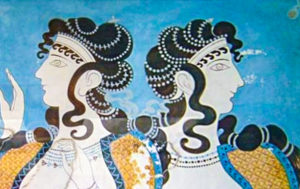 The Minoan civilization was superseded by the Mycenaean culture, ancestor of the Greek civilization.
The Minoan civilization was superseded by the Mycenaean culture, ancestor of the Greek civilization.
THE PERSIANS
Situated where Iran is today, the Persian Empire has existed a long time throughout Mesopotamian history. However, when referring to The Persian Empire, history generally refers to the empire of Cyrus the Great, a King who started the great Persian Empire from the 7th century BC until the 4th century BC. Cyrus conquered most of Mesopotamia, including Babylon. They tried to Conquer Greece but never succeeded. In fact, the Persian Empire was conquered by Alexander the Great in 330 BC.
Zarathustra (or Zoroaster) is the prophet that founded of the monotheistic religion of Persia. He is believed to have lived around 600 BC in Persia. He composed 5 songs which are written in the Zoroastrianism Bible, the Avesta.
The beliefs of Zoroastrianism are very different than those of the rest of Mesopotamia.
The revelations of Zoroaster stipulate that:
– There is only one God, Ahura Mazda, who is the creator and who is the only deity worthy of worship;
– Ahura Mazda created the world. The world is the opposite of Chaos. Humanity has a role to play to preserve the order of the world Ahura Mazda has created.
– The role of the human in preserving the world from Chaos is to keep good thoughts, actions, and moral behaviour.
– Humans should play an active role in preserving the order, not retiring from the world.
– The evil principle in the Zoroastrian religion is Angra Mainyu (Ahriman).
– However evil the world becomes, Ahura will prevail in the end of time and the world will go thought a cosmic renovation. All that is evil will then be banished to darkness and hell.
Some of the elements of Zoroastrianism still live in today’s society: they invented the Zodiac and were very good at studying the starts. They also invented the horoscope.
Zoroastrianism kept strong in Persia for centuries. It is believed to have had great influences on Judaism and Christianity. The belief in angels and demons and the organization in duality (Good and Evil) in the Judeo-Christian religions is believed to have been the influence of Zoroastrianism. When Christianity emerged in Asia Minor, Christians mingled with Zoroastrians. Gnostics currents and Manichaeism were born and declared a heresy by the Church. Later on, Catharism is believed to have been a direct descendant of Manichaeism, and thus a descendant from the mingling of Christianity and Zoroastrism.
By the 7th Century C.E., Islamic hoards conquered Persia and Zoroastrians fled the region. Remnants of the original religion can be found in Iraq, but most of the Zoroastrian fled to India, where they are today known as Parsi (Persians).
REFERENCES
“Outline on the significant history”, www.homestead.com/danwagner/files/Hittites.htm
“Egyptian Gods Theme”, http://socsci.colorado.edu/LAB/GODS/
Tour Egypt, “Egyptian Mythology”, http://touregypt.net/gods1.htm
Wikipedia, “Religions of the ancient near east” http://en.wikipedia.org/wiki/Religions_of_the_ancient_Near_East
Wikipedia, “Mesopotamian mythology” http://en.wikipedia.org/wiki/Mesopotamian_mythology
Washington University, “Hittites”, http://www.wsu.edu:8080/~dee/MESO/HITTITES.HTM
Wikipedia, “Minoan civilization” http://en.wikipedia.org/wiki/Minoan_civilization#Religion
Darmouth University; “Minoan religion”, http://projectsx.dartmouth.edu/history/bronze_age/lessons/les/15.html
Washington University, “Minoan civilization”, http://www.wsu.edu:8080/~dee/MINOA/RELIGION.HTM
Wikipedia,”Persian Empire”, http://en.wikipedia.org/wiki/Persian_Empire
Edunet, “Zoroastrianism”, http://www.edunet.ie/resources/religioninfo/zoroaster.html
Hannah Michael Gale Shapero ,”Zoroastianism”, http://www.pyracantha.com/zjc3.html

